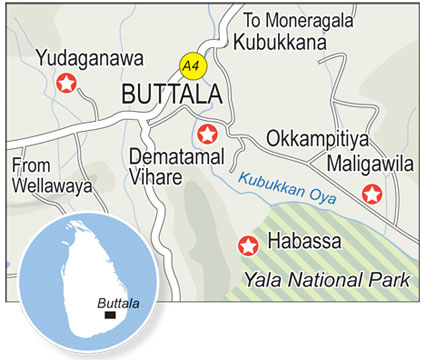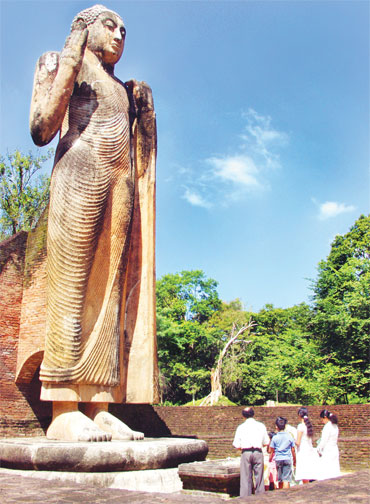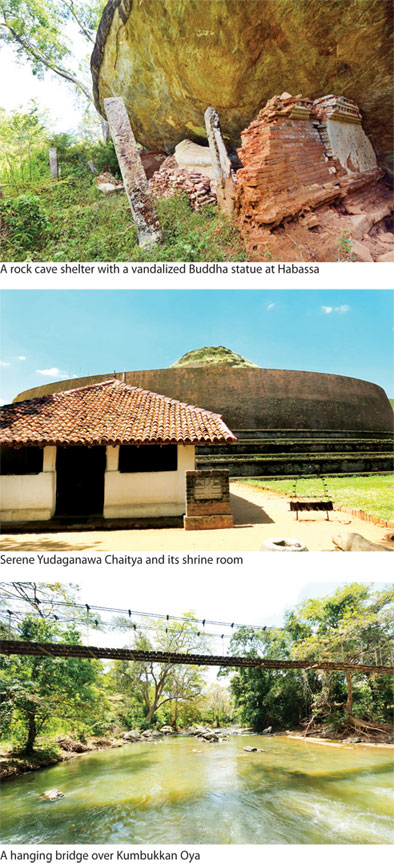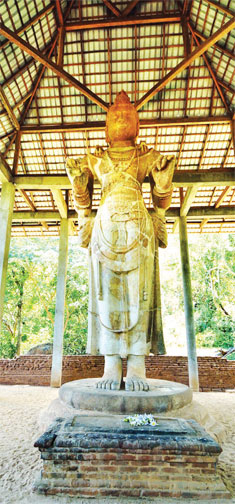Buttala Enchanting and inspiring
Story and pictures by Mahil Wijesinghe
 Buttala, nestling across the A4 highway in the Moneragala district in
the Uva Province is adorned with many tourist attractions. Among them,
the most popular is the awe-inspiring colossal Buddha statue of
Maligawila. It is considered one of the highest stone-sculptured ancient
Buddha statues in the country. Buttala, nestling across the A4 highway in the Moneragala district in
the Uva Province is adorned with many tourist attractions. Among them,
the most popular is the awe-inspiring colossal Buddha statue of
Maligawila. It is considered one of the highest stone-sculptured ancient
Buddha statues in the country.
Around 250 kilometres from Colombo, the area has at least fifteen
places of interest. It is Uva, rich in natural resources and beauty -
water bodies and waterfalls, park lands, forests and valleys. The ruins
of ancient temple complexes and their chaityas, are spread around in
several acres where modern temples have sprung up.
Buttala, now blossomed into a town, is home to sprawling lands filled
with lush green paddy fields. Apart from the archaeological site of
Maligawila, there are exotic attractions of historical and spiritual
endowment. All around Buttala we find spots of historical significance,
such as Yudaganawa, Dematamal Vihara and Habassa.
Pilgrims
Beginning our journey, first, we arrived at the archaeological site
of Yudaganawa, travelling on the Wellawaya-Buttala highway. We turned
left before reaching Buttala town and proceeded another two kilometres
on a narrow road. We glimpsed busloads of pilgrims ‘Vandana Nada’
already thronging the site despite the harsh weather.
|

A striking side view of the Maligawila standing Buddha
statue before erecting a roof over it |
It was morning and rays of the sun filtered through the skeletal
branches of huge mara trees. Since the sun is somewhat harsh in the
area, we walked underneath the trees about 200 metres to reach the site.
A colossal stupa loomed over us, around fifty feet in height, with a
miniature Budu Ge (shrine room) located in front of the stupa which
houses the Buddha statue and the wall paintings belonging to the Kandyan
period. This massive stupa was erected to mark the battlefield where the
two brothers, Prince Saddatissa and Prince Dutugemunu had fought and
made peace with each other.
The battlefield is known as, Yudaganawa, and the gigantic stupa was
named Yudaganawa Chaitya. Some historians believe that an already
existing chaitya was reconstructed and named Yudaganawa Chaitya.
Massive
The stupa is so massive that it was difficult to frame it in the
camera with a normal lens and we needed a fisheye lens to capture the
whole chaitya. Some believe it is bigger than the Abayagiriya Chaitya in
terms of circumference. Abayagiriya is considered the largest ancient
stupa in Sri Lanka.
 Despite the legends, archaeologists believe the Yudaganawa Chaitya
was first built by King Parakramababahu the Great, in memory of his
mother Queen Ratnavali who was cremated here. They expound the theory
that Yudaganawa Chaitya, which looks unfinished, is in fact, complete.
They say, in the year this Chaitya was built, a few other stupas were
also built in the same style, namely, the Damila Thupa in Polonnaruwa
and the Kotta Vehera in Dadigama. Despite the legends, archaeologists believe the Yudaganawa Chaitya
was first built by King Parakramababahu the Great, in memory of his
mother Queen Ratnavali who was cremated here. They expound the theory
that Yudaganawa Chaitya, which looks unfinished, is in fact, complete.
They say, in the year this Chaitya was built, a few other stupas were
also built in the same style, namely, the Damila Thupa in Polonnaruwa
and the Kotta Vehera in Dadigama.
In the vicinity of the Yudaganawa Chaitya is the Yudaganawa Wewa. It
is believed that the clay needed to make bricks for the Chaitya was dug
from this wewa. According to historic chronicles, the Wewa had been
built by King Mahanaga in 300 BC. It is most picturesque. In the centre
is a huge rock surrounded by huge trees, home to numerous birds.
Our next stop was the enchanting Dematamal Viharaya, seven kilometres
from Buttala, between Buttala and Okkampititya. One should not miss the
brick built chaitya at Dematamal Vihara. The temple precinct has many
white frangipani trees laden with blossoms.
It is a chaitya of historical significance, set amid lush green paddy
fields. It is supposed to be the place where Prince Saddatissa took
refuge, when he fled after losing a battle for the throne with his
brother Prince Dutugemunu. The Queen mother, Vihara Maha Devi, saddened
by the animosity between her two sons pleaded with them to make amends.
The legend goes that when Prince Dutugemunu inquired from the Bhikkus
where his brother was, the Bhikkus told him he was not on the bed. He
was in fact, under the bed, according to legend.
Here you see a unique brick built brownish coloured chaitya,
renovated in the recent past and built on a higher elevation. A new
image house has been constructed over the same foundation of the ancient
shrine room which contains an ancient Buddha statue, about ten feet in
height. Venturing further, we came across numerous ruins, reminding us
that this was once a place of great significance.
Restored
Tranquil Maligawila is only about 20 minute drive from Okkampitiya
along a narrow carpeted road. This is the site of the massive Maligawila
Buddha statue similar to the Avukana Buddha and said to be one of the
tallest, free standing Buddhist statues in Sri Lanka.
The magnificent statue in this shrine has been sculptured out of
crystalline limestone found in the area. The height of the statue is
about 38 feet, and the lotus pedestal is four feet high.
Thus, the total height of the statue is 42 feet. This 7th century
colossal statue dominates a 40 acre land and was the centre of a huge
temple complex. The statue is believed to have been commissioned by King
Aggabodhi III.
|

A magnificient Dambegoda Bodhisatva Statue at Maligawila |
Slumped to the ground in three pieces when former President R.
Premadasa first saw it, it was restored to its former glory in 1991.
Its face was repaired by Ven. Mapalagama Vipulasara Thera and
declared open to the public the same year. Recently, a modern roof has
been erected over the statue discouraging photographers who try to shoot
the statue in natural setting.
Nearby is the 34 foot gigantic Dambegoda Bodhisatva statue of
Avalokiteswara. It was broken into a hundred pieces. Some parts of it
were found through excavations. Parts of a Pilimage (shrine room) with
beautiful terracotta carvings too have been found here. The Dambegoda
Avalokiteswara and image houses are believed to have been built by King
Dappula I in the 7th century.
This area is known as Kanaagama because there was a hospital for the
blind here, in ancient times, the word kanaa being a colloquial Sinhala
term for a blind person. The blind still worship here in the hope of
restoring their sight. Now, it has become a popular site as there is an
influx of pilgrims and visitors en route to Kataragama. The vehicle park
has been developed with stalls and rows of boutiques teeming with
activity.
If you are bold and adventurous, you could venture towards the edge
of Yala Block-IV bordering Kubukkan Oya. You might like to drive off the
beaten track with a 4x4 across chena cultivations and come across some
magnificent ruined archaeological sites, such as, Habassa and
Galtemmandiya. You might encounter wild elephants when visiting Habassa,
so that it’s advisable to take a villager as guide, to the site located
15 Km from Maligawila.
Inside a long drip-ledged cave is the recumbent Buddha statue, 25
feet long. It belongs to the 9th century AD in the Anuradhapura period.
The statue has been heartlessly desecrated by treasure hunters.
All these areas are mainly wooded park lands and jungle, and as you
drive on, peacocks gaze at you without alarm, crescent hawk eagles take
quick flights, little green bee-eaters swish past, while monkeys swing
on the trees and mongoose do a dash across the road.
Before you leave, having dusted off the fatigue and eaten a delicious
piece of watermelon from a chena, you could take a refreshing dip in the
Kubukkan Oya as a finale.
|

Breathtaking view of the Chaitya of Dematamal Vihara |
|

